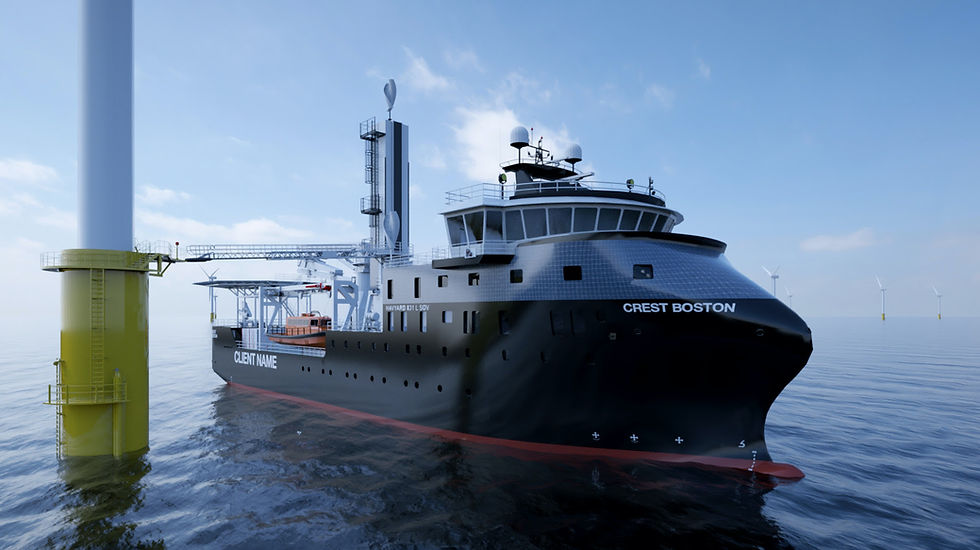OceanPact charter, Kongsberg deals, Drone swarms, WTIVs
- Sarah Whiteford
- Mar 22, 2021
- 3 min read
It’s Good News Monday!
This Monday we talk about:
Brazil's OceanPact to Charter and, Eventually, Buy Two DDW Offshore AHTS Vessels
Kongsberg scores major deal for new Dominion Energy WTIV
Drone Swarms Sent from Uncrewed Vessels Could be Used for Offshore Wind Farm Inspections
Norway: IMR to Use Kongsberg USVs, AUVs for Marine Ecosystem Monitoring
Crowley and ESVAGT Join Forces to Develop Jones Act-Compliant Offshore Wind Service Vessels

Image Credit: Offshore Engineer
Norwegian Akastor subsidiary DDW Offshore has entered a charter and sale agreement with OceanPact, a Brazilian subsea services provider for two AHTS vessels. DDW is formerly known as DOF Deepwater, and will supply Skandi Saigon and Skandi Pacific for 26 months. At the end of the charter, OceanPact will purchase the vessels, reducing debt for DDW Offshore as agreed after their restructuring.

Image credit: Ship Insight.
Kongsberg Maritime will supply technology for a new WTIV, or Wind Turbine Installation Vessel, built by Keppel for U.S.-based Dominion Energy. The new NG-16000XL WTIV will be the largest of its kind, a Jones-Act compliant vessel with the ability to install current and future generation turbines. A Kongsberg Maritime Integrated Solution “combines KM’s motion control, propulsion and dynamic positioning functionalities to maintain operability in all conditions.” Kongsberg Maritime will provide thrusters, mooring and line handling from a KM deck machinery package, and KM’s Energy Solutions for the electrical system. Egil Haugsdal, President of Kongsberg Maritime said: “We take a genuine pride in bringing the benefits of our technological expertise to all maritime sectors”.

Image Credit: Ocean Infinity. From: Offshore Engineer.
Ocean Infinity, a U.S.-based seabed survey company, is developing autonomous aerial drone swarms for wind farm inspection. They will be deployed from marine robotic vessels that are uncrewed. Ocean Infinity is working with University of Portsmouth, Airborne Robotics, and Bentley Telecom to develop the swarm that would perform autonomous inspections of wind turbines, improving safety by eliminating the need for in-person inspections. The uncrewed vessel will act as host to the drones, providing launch, landing, charging, and data transmission. The fleet of vessels is not only safer, it also is low emissions, with up to 90% fewer greenhouse gases emitted.

Image credit: Kongsberg Marine. From: Offshore Engineer.
Kongsberg Maritime, a Norwegian technology and equipment company, will provide four autonomous vessels to Norway’s Institute of Marine Research, or IMR. “The scope of supply includes two Kongsberg Maritime Sounder USVs (Unmanned Surface Vehicles) and two KONGSBERG AUVs (Autonomous Underwater Vehicles), which will form the practical basis of the institute’s long-term strategy to develop the monitoring and management of marine environments and resources.” The vessels will include Kongsberg’s Blue Insight cloud ecosystem to handle remote operations, and data management and visualization. The project includes “Infrastructure for automated classification of fish through machine learning”. The AUVs should be delivered this year, with the USVs next summer/fall 2022.

Illustration courtesy Crowley/ESVAGT. Image from: gCaptain.
Crowley, a U.S.-based company, has partnered with ESVAGT, a Danish shipping company, to develop Jones Act vessels. Crowley will be the owner/operator of the vessels with ESVAGT providing “technical advice on the design, construction, and operation of these vessels.” There is a current shortage in Jones Act compliant vessels for the U.S. offshore wind sector, while planned offshore wind farms have increasing. ESVAGT is an expert in SOVs in Europe, and Crowley recently formed a new division to support emerging energy sectors.
Smile, it’s Good News Monday! :-)
Comments